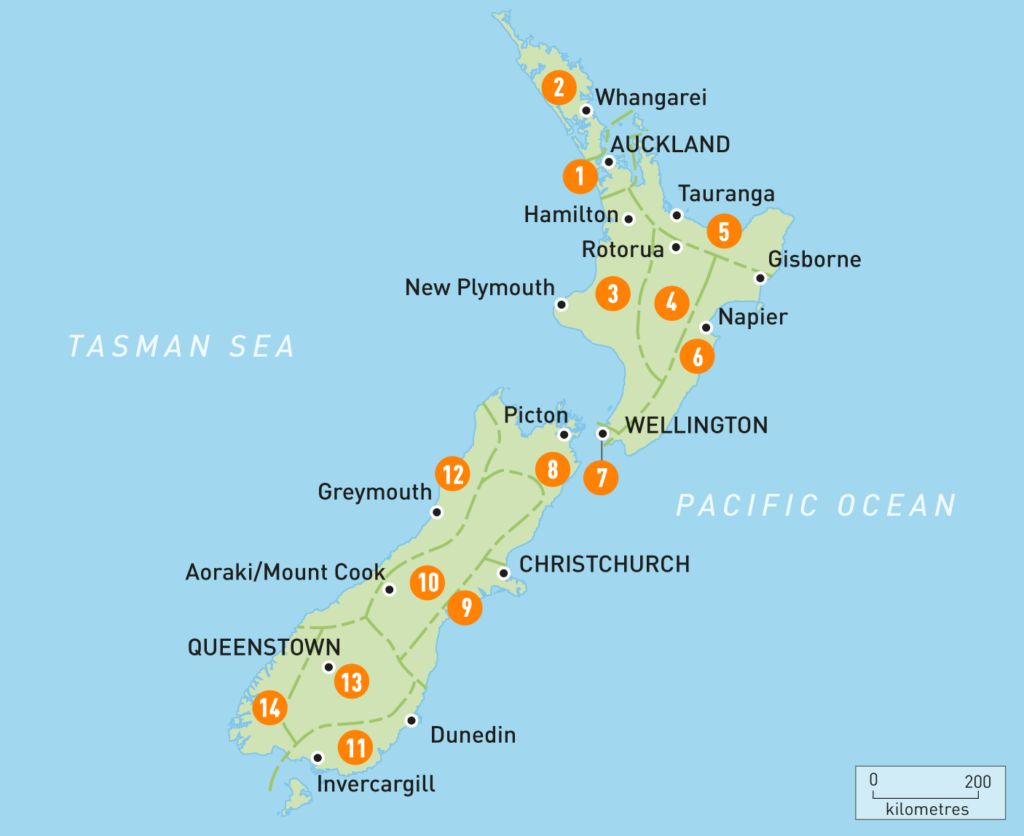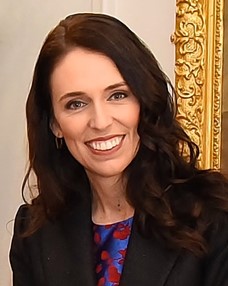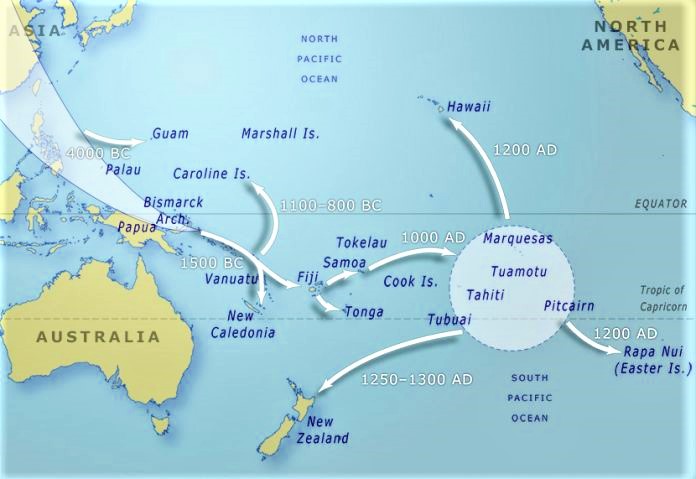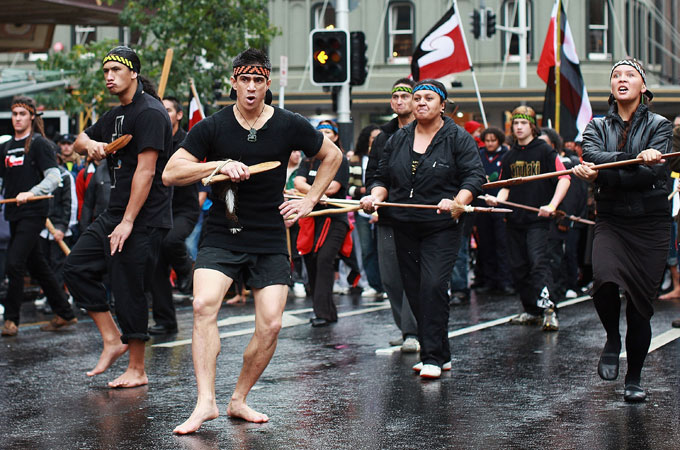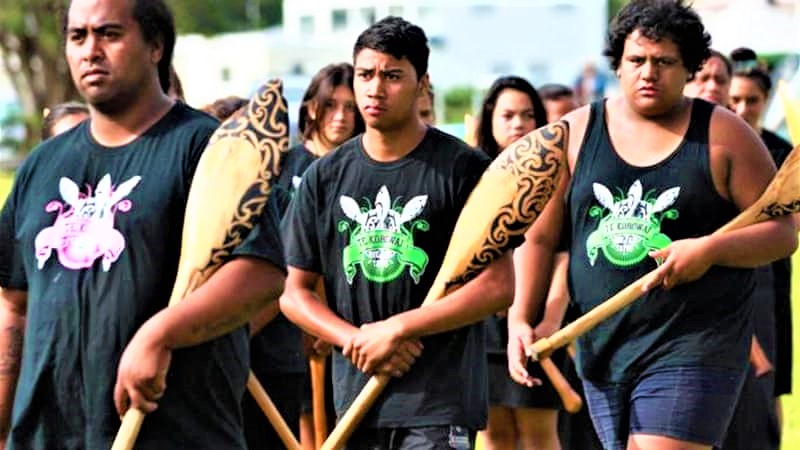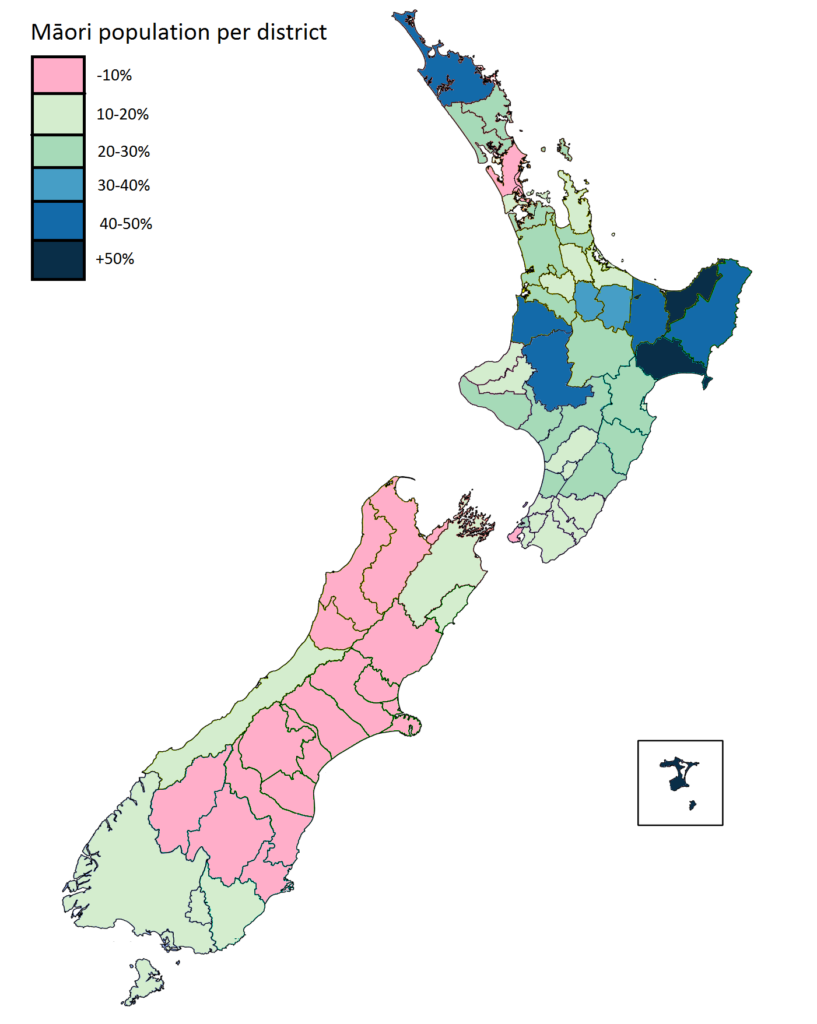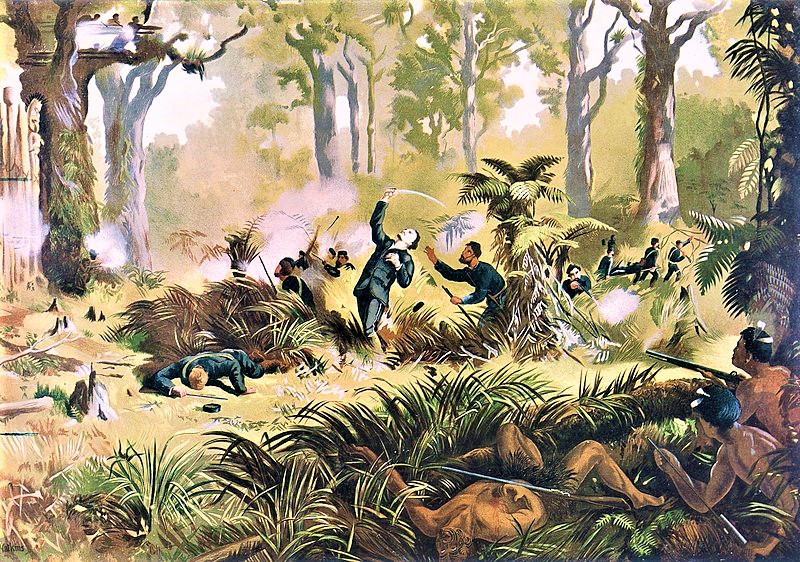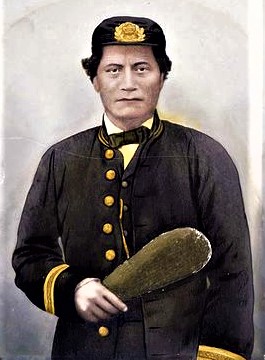The Lot of the Exploited, Discriminated and Oppressed (Part 3)
TRANSCEND MEMBERS, 27 Dec 2021
Prof Hoosen Vawda – TRANSCEND Media Service
Is It Predestination, Karma, or Hedonistic Colonial Subjugation by People of Aryan Origins? An Odyssey of Generational Suffering of Humanoids of Colour
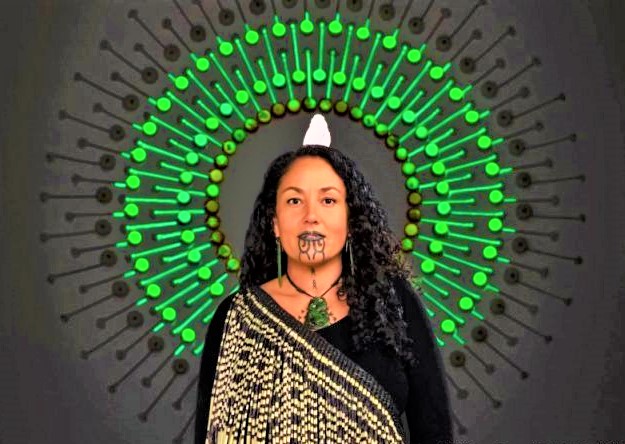
Ms Ngahina Hohaiaa a Māori artist with a moko kauae has exposed the harsh reality that racism exists in Aotearoa
23 Dec 2021- In Part 1 of this paper[1],[2] the serious level of discrimination, random rape and murder of the Dalits in India was presented, while in Part 2, the oppression and subjugation of the indigenous people of the former South West Africa, presently Namibia, the Hereros, was discussed.
This paper analyses the plight of the dark-skinned, phenotypically different from the Aryan, White race, humanoids, the Maoris of New Zealand and the Pacific Islanders, is highlighted. The liberal, democratic government of the Prime Minister Jacinda Ardern[3] is still faced with discrimination against the Maori people, which borders on xenophobia by the White race in New Zealand of British origins.
New Zealand consists of three islands, the North, South and over 700 smaller islands, covering a total area of 268,021 square kilometres. The largest is Stewart Island, with the volcanic conglomeration resembling a fish or an inverted boot. It has a population of 5.084 million in 2020. Today, the majority of New Zealand’s population of 5 million is of European descent; the indigenous Māori are the largest minority, followed by Asians and Pacific Islanders. Reflecting this, New Zealand’s culture is mainly derived from Māori and early British settlers, with recent broadening of culture arising from increased immigration. The official languages are Māori and New Zealand Sign Language, with English being dominant and a de facto official language.[4]
It is natural to assume that there would be no racism in New Zealand under the humanistic government of Jacinda Ardern as aptly exemplified by the Christchurch mosque shooting in 2020 when the government response was unparallel for any country when Muslims are attacked as a part of Islamophobia and Muslimophobia. However, racism reared its ugly spectre, as recently as June 2021. Overt anti-Maori people and cultural sentiments were openly expressed by the White community in Auckland, the largest city in New Zealand.
A racial attack against a Māori artist with a moko kauae[5] has exposed the harsh reality that racism exists in Aotearoa[6], as reported by Jessica Tyson on Friday 12 June 2020.[7] The Moko kauae is the reassertion of an Indigenous right that has been marginalised, demeaned and denied by Pākehā colonial dominance, of White, people of Artan origins. It is not a right for Pākehā[8] women. Tohunga-tā-moko (tattooists) were considered tapu, or inviolable and sacred.[9]
Ms Ngahina Hohaia a Māori artist, stated that she visited Ōwairaka[10], Mt Albert [11]in Auckland to go for a walk but was physically assaulted and verbally abused by a Pākeha woman. “I told her to hold on to her dog as she let it walk in front of my moving car. She responded with “shut up you black b****, you disgraceful idiots who go around with those moko on your face,” “As I took my phone out of my pocket she stepped toward me and hit me. She then sped off in her car.” Police are investigating the alleged attack. Hohaia’s media spokesperson, Tina Ngata, says the incident has generated conversation about racism in New Zealand. It is apparent that “New Zealand tends to labour under a myth that we are racially harmonious and so, when we come across instances like this, it tends to generate a lot of indignity and a lot of people asking questions around it.” Ngata says Hohaia was left shaken after the incident. “This is a really specific kind of abuse that wasn’t just against Ngahina as a woman, Ngata says.” It was against Ngahina as a Māori and it was against her tīpuna, her ancestors because, when we wear our moko, we wear our ancestors. “She’s a resilient person. She’s a strong wahine Māori and I know that she’ll continue to be resilient.” Ngata says it would be relatively easy to live in Aotearoa and “fool yourself that this kind of thing doesn’t happen. “It would more than likely be that you are lighter-skinned, don’t wear moko, are not Māori, or don’t present yourself as Māori. Once you start wearing moko, or if you are dark-skinned, or if you do speak the reo often in day-to-day life, present yourself as Māori, then you do come across this kind of racism more often.” The woman who abused Hohaia was there with the Honour the Maunga[12] protest group, which has been fighting to stop the felling of exotic trees to protect birdlife. “It doesn’t surprise me that that person came out of that colonial occupation as well because that is a prime example of a movement of racism that is cloaked in white environmentalism. So that’s where you’ll find that type of racism.” Ngata says it’s time for the government to start paying more attention to the specific colonial racism in Aotearoa. This type of personal attack against the indigenous Maori people of New Zealand emanates from the universal philosophy of white, supremist, colonials who consider themselves as originating from a superior Aryan stock, compared with the dark-skinned Maori people, after invading and occupying their sacred land from the time of the exploratory voyages of Captain James Cook of the British Royal Navy, famous for his three voyages between 1768 and 1779 in the Pacific Ocean and to Australia in particular.[13]
Historically, the indigenous navigation of the Pacific Ocean and its settlement began thousands of years ago. The inhabitants of the Pacific islands had been voyaging across vast expanses of ocean water sailing in double canoes or outriggers, using nothing more than their knowledge of the stars and observations of sea and wind patterns to guide them.[14] The Pacific Ocean is one-third of the earth’s surface and its remote islands were the last to be reached by humans. These islands are scattered across an ocean that covers 165.25 million square kilometres. The ancestors of the Polynesians, the Lapita people, set out from Taiwan and settled Remote Oceania between 1100-900 BCE, although there is evidence of Lapita settlements in the Bismarck Archipelago as early as 2000 BCE. The Lapita and their ancestors were skilled seafarers who memorised navigational instructions and passed their knowledge down through folklore, cultural heroes, and simple oral stories.[15]
The Polynesian’s highly developed navigation system impressed the first European explorers of the Pacific and since then scholars have been debating several questions:-
- Just as in the present day, mass migration, from impoverished countries, amid civil wars and political turmoil, the question which is often raised, is what was the reason and motivating factor for this migration of Polynesians, across the treacherous Pacific Ocean, infested with huge sharks such as the Great White, popularised by the 1975 American movie, “Jaws”[16].
- Was the migration and settlement of the Pacific islands and into Remote Oceania accidental or intentional?
- Was this oceanic migration, due to famine, rising sea levels, infectious diseases, divine, ancestral callings, or simply the spirit of adventure of the Polynesians?
- What were the specific maritime, sailing skills and engineering sophistication of the canoes, of these ancient seafarers, which enabled them to cross vast stretches of deep ocean and without any availability of modern navigational technology?
- Why has a large body of indigenous navigational knowledge been lost and what can be done to preserve what remains?
- What was the structural integrity of the sailing vessels and if sails were used to cross an open ocean?
- How did the Polynesians survive in terms of fresh water and food on the small canoes in which entire families were transported?
While most of these relevant questions, remain unanswered and further research needs to be done before vestiges of oral Maori history is lost forever, the Maoris were the first humans to inhabit New Zealand and are rightfully the indigenous people, of New Zealand. The Maoris certainly arrived well before the invasion of the European-Aryan colonialist stock, occupying their sacred land, in most cases, with total disregard for the traditions, culture, ancestral beliefs, value systems, indigenous knowledge systems and language of the Maori people of Polynesia origins.[17]
Currently, the Maori groups are protesting in New Zealand over child removals and use of sacred land, as in the past. The Maoris ae taking to the streets to protest family separations carried out by the child welfare agency and a planned development on their ancestral lands.
The protests have strained relations between Maori and the Labour coalition government led by Jacinda Ardern, who has been in the remote Pacific territory of Tokelau at a time of rising tension at home as reported in 2019. Hundreds of protesters marched in Auckland, New Zealand’s largest city, and other cities around the country, according to Reuters. The taking of infants into state care, a process known as “uplifting”, has been making headlines in the country since mid-June 2019, when an investigation by local media outlet Newsroom showed authorities attempting to take a seven-day-old baby from its 19-year-old Maori mother while she was still in the maternity ward.[18]
Some have raised concerns that Maori and Pacific Island babies are disproportionately affected by “uplifts” due to institutional racism. Over 15,000 people have signed an open letter online urging the government to “stop stealing Maori children.” However, the New Zealand launches investigation into Maori babies taken into state care. Last year, judges ordered 281 babies to be taken into care and 71% were of Maori or Pacific Island heritage, the government said in a statement. In New Zealand’s most recent census in 2013, 14.9% of the then population of 4.2 million people identified as Maori, while 7.4% identified as of Pacific Island heritage. Judge Andrew Becroft, the New Zealand Children’s Commissioner, announced his office’s own inquiry on June 16, citing long-running concerns. “Consequently we have decided to exercise our specific statutory power under the Children’s Commissioner Act to monitor and assess the policies of Oranga Tamariki,” tweeted Becroft. On June 19, 2021, New Zealand’s Chief Ombudsman Peter Boshier announced a wide-ranging, independent investigation into the Ministry for Children’s uplifting process.
The controversy is reminiscent of the “stolen generation” of Aboriginal children in Australia.
New Zealand has one of the worst rates of child abuse in the developed world. According to Unicef, the children’s ministry receives over 150,000 reports of concern relating to the country’s 1.1 million children, each year. In 2017, the government created Oranga Tamariki after finding that the system under the former ministry, was “ineffective” and had poor long-term outcomes for children in care. However, the newly-formed Oranga Tamariki has also come under fire. In March, 2021, it announced that in the second half of 2018, there were over 300 instances of neglect, emotional, sexual or physical abuse of children in its care.
Protests over Oranga Tamariki’s treatment of Maori children came at the same time as Maoris in Auckland mobilised against a proposed housing project on land they consider to be sacred, Reuters reported. The disputes put Ardern’s government in a tough spot, as Maori votes are important to the prime minister’s Labour party, said Bryce Edwards, a political commentator at Wellington’s Victoria University, according to the news agency.[19]
In the 19th century, there was overt and official discrimination, great oppression of and disdain towards the Maoris. Intolerance towards indigenous people is typical of colonial societies. Māori, as individuals and communities, were the subject of racism and discrimination as Europeans settled in New Zealand in the 19th century.
However, the extent and nature of intolerance varied. Partly because of their strength in war and political negotiation, Māori were accorded civil rights through the Treaty of Waitangi, more than a century before Aboriginal people became full citizens of Australia. Māori had four seats in Parliament from 1867, and were members of national sports teams from the beginning. There was a general acceptance of intermarriage. It was commonly thought by Pākehā that Māori were genetically superior to other native peoples, and at the end of the 19th century they were considered to be Aryans, like Anglo-Saxons.[20] In 1898 politician and historian William Pember Reeves wrote: ‘The average colonist regards a Mongolian with revulsion, a Negro with contempt, and looks on an Australian black as very near to a wild beast; but he likes the Maoris, and is sorry that they are dying out.’[21]
The intolerance of most White people was based less on an assumption of genetic superiority than of cultural superiority. The conversion of Māori to Christianity, the usurping of their resources, notably land for farming by settlers and the growing dominance of the institutions of the New Zealand state were based on beliefs about the superiority of European civilisation and the perceived backwardness of Māori culture. Māori schooling was based on the assumption that Māori were capable of becoming westernised as ‘honorary whites.”[22] There were instances of racist intolerance. When large areas of Taranaki were confiscated from Māori in 1865 after the Taranaki wars, this included the land of tribes who had not fought against the government. They lost land purely because they were Māori.[23] In early 20th century discrimination against the Maoris was resuscitated. The effects of war and disease had a major impact on the size and health of Māori communities until the early 20th century. Discriminatory aspects of New Zealand were still very obvious until the 1960s. From 1926 Māori normally received 25% less than the full rate for old-age and widows’ pensions. Despite the Labour government’s claims of equality, discrimination by the pensions department continued into the 1940s. Not until 1945, following the full participation of Māori in the Second World War, was this discrimination stopped.[24] In 1959 Dr Harry Bennett, a senior medical officer in an Auckland hospital, was refused a drink in the bar of a local hotel because he was Māori. Other hotels refused bookings from Māori. Rental properties were advertised for ‘Europeans only’, and in some places Māori were kept separate from Pākehā in cinemas and swimming pools.[25] This policy was reminiscent of the apartheid legislature in South Africa, formulated by the British and perfected by the Nationalist Afrikaner government in 1948.
In 1937 senior Treasury official Bernard Ashwin[26] explained Māori levels of pension payments: ‘On the face of it, it may appear equitable to pay the average Māori old-age pensioner the same amount per week as the average European pensioner, but in this matter questions of equity should be decided having regard to the circumstances, the needs and the outlook on life of the individuals concerned … the living standard of the Māori is lower – and after all, the object of these pensions is to maintain standards rather than to raise them.’[27]
After 1945 there was Māori migration and restored mana, with the indigenous people moving to the city. This meant that Māori and Pākehā had greater contact as they intermingled in urban areas, and a new generation of Māori grew up without significant contact with their cultural heritage.[28]
In the late 1960s Māori organisations, influenced by the American black civil-rights movement, challenged the way their culture and rights had been treated. They received support from Pākehā groups such as the Auckland Committee on Racism and Discrimination (ACORD), which researched the discriminatory treatment of Māori. Attitudes to race relations changed between the late 1960s and the mid-1980s. The Race Relations Act 1971 prohibited discrimination on the basis of race, nationality or ethnic origin. A Race Relations Conciliator was appointed to set up procedures for investigating complaints about discrimination. Under the Human Rights Commission Act 1977, discrimination on the grounds of marital status, sex, religion and ethical belief also became illegal. Pākehā intolerance and institutional discrimination were extensively challenged. Māori activism about land rights, culture and language led to the establishment of the Waitangi Tribunal in 1975 to investigate alleged breaches of Te Tiriti o Waitangi. From 1985 the Waitangi Tribunal could investigate breaches dating back to 1840. Māori whānau, hapū and iwi presented their claims to the Tribunal relating to many actions by the Crown that were breaches of the Treaty. On the basis of findings by the Waitangi Tribunal the Crown embarked on a range of settlements, starting in the late 1980s.[29]
There was a new sensitivity towards Māori by state organisations, reparations for Treaty of Waitangi breaches, and the restoration of resources such as fisheries, in 1992, to Māori ownership. Māori were active in establishing new institutions such as kōhanga reo (language learning nests) to foster their cultural interests. While the settlement process was often demanding and slow, and institutional change was difficult, New Zealand in the 2000s was a very different place for Māori than it had been previously.
However, this journey was not an ease one as in South Africa where in the liberation struggle, many Maoris were killed. The New Zealand Wars took place from 1845 to 1872 between the New Zealand Colonial government and allied Māori on one side and Māori and Māori-allied settlers on the other. They were previously commonly referred to as the Land Wars or the Māori Wars[30] while Māori language names for the conflicts included Ngā pakanga o Aotearoa (“the great New Zealand wars”) and Te riri Pākehā (“the white man’s anger”). [31] Historian James Belich popularised the name “New Zealand Wars” in the 1980s,[32] although the term was first used by historian James Cowan in the 1920s.[33]
There is extensive literature on the Maori Wars, with bloody battles, ambushes and narrating atrocities on both sides. However, the colonial forces were professional soldiers having fought in India, Afghanistan and other countries. They had superior weaponry and were excellent tacticians. There were also Maoris who opted to fight on the side of the colonial forces against their fellow kind. This was also and is, even at present, the philosophy of the British to divide and rule as they did with the Partition in India, resulting in Hindus and Muslims fighting each other, with religiously based massacres on both sides, killing their own kind.
A 2013 Waitangi Tribunal report said the action of Crown forces on the East Coast from 1865 to 1869, the East Coast Wars and the start of Te Kooti’s War, resulted in the deaths of proportionately more Māori than in any other district during the New Zealand wars. It condemned the “illegal imprisonment” on the Chatham Islands of a quarter of the East Coast region’s adult male population and said the loss in war of an estimated 43 percent of the male population, many through acts of “lawless brutality”, was a stain on New Zealand’s history and character.[34] During this time, the imprisoned Maori Chiefs who fought against the colonial forces were extremely tortured, and some of them even had both their hands cut off by the British officers , starving them to death, as was informed to the author on a visit to the Islands in 2000 by the local hosts. In other cases, the Maoris were starved to death by the British burning the farms and killing off the protein food source the Moa bird. According to Māori tradition, moa were swift runners that defended themselves by kicking when cornered. Early Polynesian peoples hunted moa for food and made spear points, hooks, and ornaments from their bones and water carriers from their eggs. Although the larger moa probably became extinct by the end of the 17th century, a few smaller species may have survived into the 19th.[35]
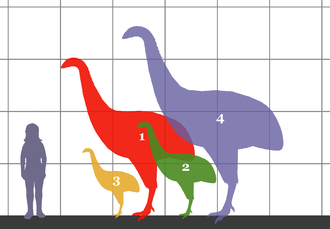
A size comparison between four New Zealand moa species and a human 1. Dinornis novaezealandiae 2. Emeus crassus 3. Anomalopteryx didiformis 4. Dinornis robustus.[36]
The question, which we all need to ask, is why is this racial bias and prejudice still present in the 21st century and what are we, as fellow humanoids, doing about it, collectively and globally to combat this social cancer, while victims are succumbing to this malady?
References:
[1] https://www.transcend.org/tms/2021/12/the-lot-of-the-exploited-discriminated-and-oppressed-part-1/
[2] https://www.transcend.org/tms/2021/12/the-lot-of-the-exploited-discriminated-and-oppressed-part-2/
[3] https://en.wikipedia.org/wiki/Jacinda_Ardern
[4] https://en.wikipedia.org/wiki/New_Zealand#:~:text=Today%2C%20the%20majority,facto%20official%20language.
[5] https://kaupapamaori.com/2018/05/23/moko-kauae-a-maori-womens-right/
[6] https://en.wikipedia.org/wiki/Aotearoa
[7] https://www.teaomaori.news/racial-attack-against-maori-artist-exposes-racism
[8] https://en.wikipedia.org/wiki/P%C4%81keh%C4%81
[9] https://www.bing.com/search?q=moko+kauae+&form=STARH1&refig=18ab04c97f3c45108c786d9636b3f1de&mkt=en-za&ocid=winp1taskbar#:~:text=of%20New%20Zealand.-,Tohunga%2Dt%C4%81%2Dmoko%20(tattooists)%20were%20considered%20tapu%2C%20or%20inviolable%20and%20sacred.,-Wikipedia
[10] https://www.aucklandcouncil.govt.nz/arts-culture-heritage/heritage-walks-places/Pages/owairaka-mt-albert-walks.aspx
[11] http://en.wikipedia.org/wiki/Mount_Albert_(New_Zealand)
[12] https://honourthemaunga.org.nz/
[13] https://en.wikipedia.org/wiki/James_Cook
[14] https://www.councilpacificaffairs.org/news-media/indigenous-navigation-settlement-of-the-pacific/#:~:text=Indigenous%20navigation%20of,to%20guide%20them.
[15] https://www.councilpacificaffairs.org/news-media/indigenous-navigation-settlement-of-the-pacific/#:~:text=The%20Pacific%20Ocean%20is,and%20simple%20oral%20stories
[16] https://en.wikipedia.org/wiki/Jaws_(film)#:~:text=Jaws%20is%20a%201975%20American%20thriller%20film%20directed,based%20on%20the%201974%20novel%20by%20Peter%20Benchley.
[17] https://www.councilpacificaffairs.org/news-media/indigenous-navigation-settlement-of-the-pacific/
[18] https://www.cnn.com/2019/06/19/asia/nz-newborn-children-removed-intl-hnk/index.html#:~:text=Taking%20infants%20into%20state%20care,was%20still%20in%20the%20maternity
[19] https://www.cnn.com/profiles/julia-hollingsworth
[20] https://teara.govt.nz/en/ethnic-and-religious-intolerance/page-1#:~:text=Intolerance%20towards%20indigenous,like%20Anglo%2DSaxons.
[21] William Pember Reeves, The long white cloud (Ao-tea-roa). London: Horace Marshall & Son, 1898, p. 57. Back
[22] https://teara.govt.nz/en/ethnic-and-religious-intolerance/page-1#:~:text=The%20intolerance%20of,as%20%E2%80%98honorary%20whites%E2%80%99.
[23] https://teara.govt.nz/en/ethnic-and-religious-intolerance/page-1#:~:text=There%20were%20instances%20of%20racist%20intolerance.%20When%20large%20areas%20of%20Taranaki%20were%20confiscated%20from%20M%C4%81ori%20in%201865%20after%20the%20Taranaki%20wars%2C%20this%20included%20the%20land%20of%20tribes%20who%20had%20not%20fought%20against%20the%20government.%20They%20lost%20land%20purely%20because%20they%20were%20M%C4%81ori.
[24] https://teara.govt.nz/en/ethnic-and-religious-intolerance/page-1#:~:text=Early%2020th%2Dcentury,this%20discrimination%20stopped.
[25] https://teara.govt.nz/en/ethnic-and-religious-intolerance/page-1#:~:text=In%201937%20senior,to%20raise%20them.%E2%80%99
[26] https://teara.govt.nz/en/ethnic-and-religious-intolerance/page-1#:~:text=In%201937%20senior,to%20raise%20them.%E2%80%99
[27] https://teara.govt.nz/en/ethnic-and-religious-intolerance/page-1#:~:text=In%201937%20senior,to%20raise%20them.%E2%80%99
[28] https://teara.govt.nz/en/ethnic-and-religious-intolerance/page-1#:~:text=M%C4%81ori%20migration%20and,their%20cultural%20heritage.
[29]https://teara.govt.nz/en/ethnic-and-religious-intolerance/page-1#:~:text=M%C4%81ori%20activism%20about,the%20late%201980s.
[30] http://www.nzhistory.net.nz/war/new-zealand-wars/end
[31] http://www.teara.govt.nz/en/video/36902/the-end-of-the-war
[32] http://www.teara.govt.nz/en/video/36902/the-end-of-the-war
[33] https://en.wikipedia.org/wiki/New_Zealand_Wars#CITEREFO’Malley2019
[34] https://web.archive.org/web/20160216151926/https://forms.justice.govt.nz/search/Documents/WT/wt_DOC_69285748/Mangatu%20Pre-pub%20Website.pdf
[35] http://www.birdlife.org/datazone/speciesfactsheet.php?id=5353
[36] https://en.wikipedia.org/wiki/Moa#:~:text=A%20size%20comparison,4.%20Dinornis%20robustus
______________________________________________
 Professor G. Hoosen M. Vawda (Bsc; MBChB; PhD.Wits) is a member of the TRANSCEND Network for Peace Development Environment.
Professor G. Hoosen M. Vawda (Bsc; MBChB; PhD.Wits) is a member of the TRANSCEND Network for Peace Development Environment.
Director: Glastonbury Medical Research Centre; Community Health and Indigent Programme Services; Body Donor Foundation SA.
Principal Investigator: Multinational Clinical Trials
Consultant: Medical and General Research Ethics; Internal Medicine and Clinical Psychiatry:UKZN, Nelson R. Mandela School of Medicine
Executive Member: Inter Religious Council KZN SA
Public Liaison: Medical Misadventures
Activism: Justice for All
Email: vawda@ukzn.ac.za
Tags: Colonialism, Deep Culture, Deep Structure, Division, Europe, Genocide, Indigenous, Indigenous Culture, Indigenous Rights, Inequality, Maoris, New Zealand, Pacific Islands, Racism, Social conflict, Social contract, Social structures
This article originally appeared on Transcend Media Service (TMS) on 27 Dec 2021.
Anticopyright: Editorials and articles originated on TMS may be freely reprinted, disseminated, translated and used as background material, provided an acknowledgement and link to the source, TMS: The Lot of the Exploited, Discriminated and Oppressed (Part 3), is included. Thank you.
If you enjoyed this article, please donate to TMS to join the growing list of TMS Supporters.

This work is licensed under a CC BY-NC 4.0 License.
